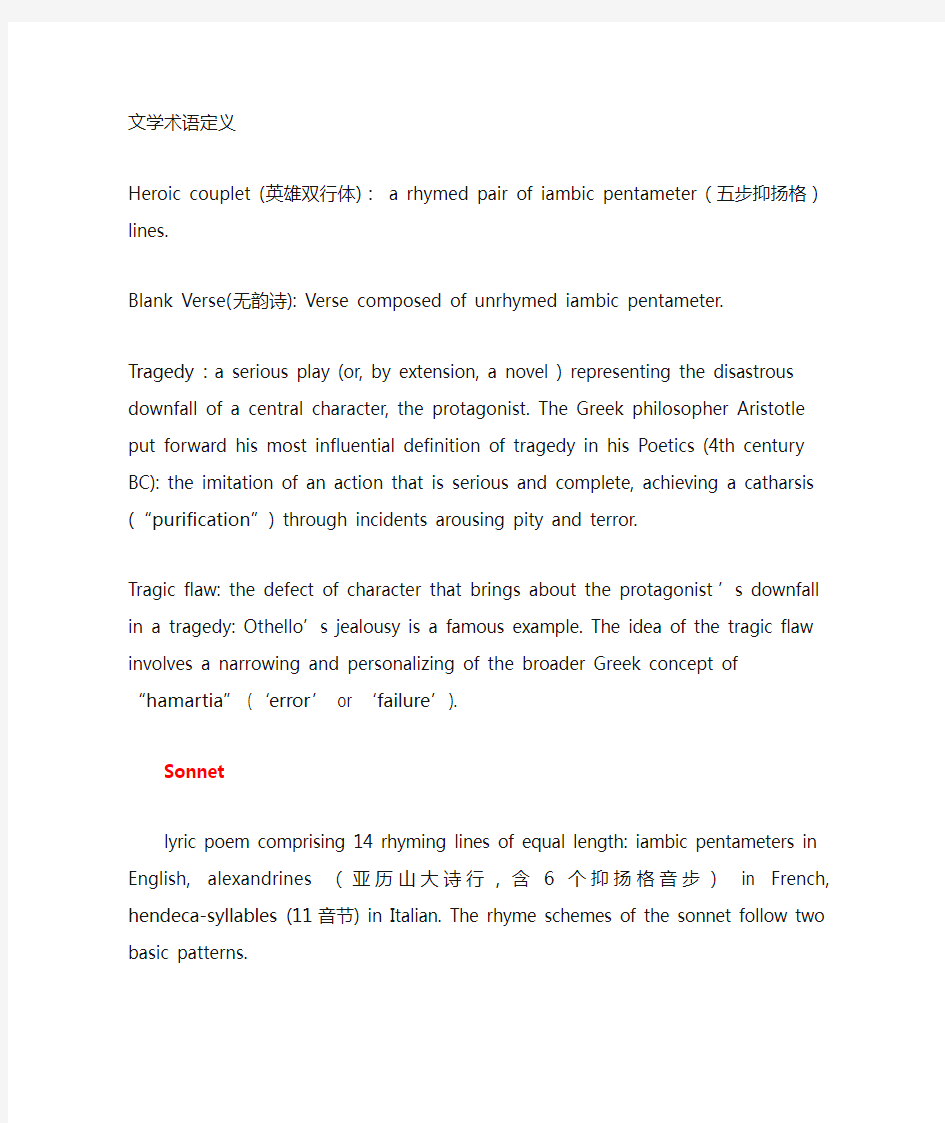tragedy, foot,sonnet 等定义


文学术语定义
Heroic couplet (英雄双行体): a rhymed pair of iambic pentameter(五步抑扬格)lines.
Blank Verse(无韵诗): Verse composed of unrhymed iambic pentameter.
Tragedy:a serious play (or, by extension, a novel ) representing the disastrous downfall of a central character, the protagonist. The Greek philosopher Aristotle put forward his most influential definition of tragedy in his Poetics(4th century BC): the imitation of an action that is serious and complete, achieving a catharsis (“purification”) through incidents arousing pity and terror.
Tragic flaw: the defect of character that brings about the protagonist?s downfall in a tragedy: Othello?s jealousy is a famous example. The idea of the tragic flaw involves a narrowing and personalizing of the broader Greek concept of “hamartia” (…error? or …failure?).
Sonnet
lyric poem comprising 14 rhyming lines of equal length: iambic pentameters in English, alexandrines (亚历山大诗行,含6个抑扬格音步)in French, hendeca-syllables (11音节) in Italian. The rhyme schemes of the sonnet follow two basic patterns.
(1) The Italian Sonnet (Petrarchan sonnet)comprises of an 8-line octave of 2 quatrains, rhymed abba abba, followed by a 6-line sestet usually rhymed cde cde or cdc dcd.
(2)The English sonnet (also called the Shakespearean sonnet after its foremost practitioner) comprises 3 quatrains and a final couplet, rhyming abab cdcd efef gg. An important variant of this is Spenserian sonnet (introduced by the Elizabethan poet Edmund Spencer), which links the 3 quatrains by rhyme, in the sequence ababbabacdcdee. In either form, the “turn” comes with the final couplet, which may sometimes achieve the neatness of an epigram(警句).
十四行诗,又译“商籁体”,为意大利文sonetto,英文、法文sonnet的音译。欧洲一种格律严谨的抒情诗体。最初流行于意大利,彼特拉克的创作使其臻于完美,又称“彼特拉克体”,后传到欧洲各国。由两节四行诗和两节三行诗组成,每行11个音节,韵式为ABBA,ABBA,后两节六行或两韵变化,或三韵变化。16世纪,经英国莎士比亚的发展,称为“莎士比亚体”或“伊丽莎白体”,由三节四行诗和两行对句组成,每行10个音节,韵式为ABAB,CDCD,EFEF,GG。
3.音步(Foot):
(Prosody) a group of syllables constituting a metrical unit. In English poetry it consists of stressed and unstressed syllables, while in ancient classical poetry it consists of long and short syllables
英诗中重读与非重读音节的特殊性组合叫作音步。一个音步的音节数量可能为两个或三个音节,但不能少于两个或多于三个音节,而且其中只有一个必须重读。分析英诗的格律就是将它划分成音步,并区分出是何种音步以及计算音步的数量。这种音步划分叫scansion。根据一首英诗组成的音步数量,每一诗行一个音步称“单音步”(monometer);每一诗行有两
个音步的,称“双音步”(dimeter);含有三个音步的,称“三音步”(trimeter);此外还有四音步(tetrameter)、五音步、(pentameter)、六音步(hexameter)、七音步(heptameter)、八音步(octameter)。-meter:poetic meter (韵律, 格律)with a given number of feet1(诗的)音步
